June 16, 2017
Air Date: June 16, 2017
FULL SHOW
SEGMENTS
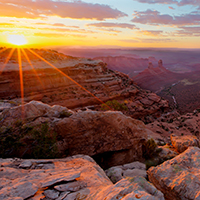
Shrinking Bears Ears
View the page for this story
Interior Secretary Ryan Zinke’s interim report recommends that Bears Ears National Monument’s 1.3 million-acre area be shrunk. The Antiquities Act that allows Presidents to create National Monuments but has no mechanism for Presidents to reduce or undo them. Bears Ears National Monument contains many sacred and historical sites for Native Americans and Living on Earth host Steve Curwood and Tracy Coppola, a Senior Legislative Counsel with Earthjustice, discuss the politics at play and the future for Bears Ears. (06:45)
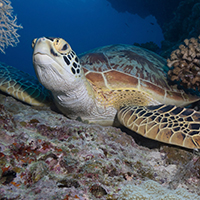
Beyond the Headlines
/ Peter DykstraView the page for this story
Peter Dykstra returns and with host Steve Curwood notes antibiotic-resistant bugs in sea turtles on the Great Barrier Reef and hogs in rural Denmark. Then, they reflect on the anniversary of crusade of “Smoky” Joe Barton, a U.S. Congressman who viewed the Obama administration's response to the Deepwater Horizon oil spill as a “shakedown” or BP, and sought an apology. (03:00)

A Tale of Two Numbers: Exxon’s Alleged Climate Fraud
View the page for this story
New York Attorney General Eric Schneiderman says he has evidence that ExxonMobil misrepresented its climate risks to investors by using two different sets of books for its climate accounting, a charge the company disputes. Dave Hasemyer of InsideClimate News tells host Steve Curwood about the alleged fraud, how Exxon is responding, and the pressure from investors and the public for the company to be more forthcoming about climate risks. (10:10)
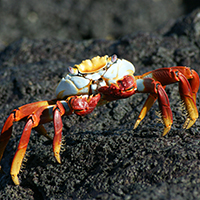
Science Note: Crab Shells Fight Malaria
/ Don LymanView the page for this story
Despite a century of research, malaria remains a major health threat, killing as many as half a million a year. Now Chinese scientists have found crushed crab shells mixed with a common chemical and sprayed over reservoirs effectively kills mosquito larvae, as Living on Earth’s Don Lyman reports. (02:00)

Saving Fancy Fish
View the page for this story
Hawaiian dive expert Robert Wintner, known as ‘Snorkel Bob,’ has campaigned for 11 years to stop the capture of wild reef fish for the aquarium trade. Now the state of Hawaii has passed a bill to ban the trade there and Robert Wintner tells host Steve Curwood that he’s cautiously optimistic Governor David Ige will sign it. (07:45)

Gulls Hunting Spider Crabs
/ Mark Seth LenderView the page for this story
Seagulls don’t have the best of reputations; people even call them “rats with feathers” and some think they’re rather stupid. But Living on Earth’s Explorer in Residence Mark Seth Lender disagrees and marvels as Herring Gulls and Black-backed Gulls skillfully hunt for spider crabs on the Connecticut Shore. (03:00)

Houston Hurricane Risks
View the page for this story
The tanks and refineries of the massive oil and gas infrastructure that Texas is famous for leave the city of Houston at risk for devastation and massive loss of life from storm surges if a major hurricane were to hit. Neena Satija of the Texas Tribune was part of the Peabody-winning team that investigated the risks, and spoke with Living on Earth Host Steve Curwood about the factors that could spell disaster, and what can be done to reduce risk. (14:40)
Show Credits and Funders
Show Transcript
HOST: Steve Curwood
GUESTS: Tracy Coppola, David Hasemyer, Robert Wintner, Neena Satija
REPORTERS: Don Lyman, Peter Dykstra, Mark Seth Lender
[THEME]
CURWOOD: From Public Radio International, this is Living on Earth.
[THEME]
CURWOOD: I’m Steve Curwood.
The New York attorney general alleges that Exxon used two set of books to mislead its investors about the oil giant’s regulatory and financial risks from climate change.
HASEMYER: Exxon presented one picture to the public that showed the company was being conservative, while internally they were using a much more aggressive number that showed far less risk.
CURWOOD: Also, after 11 years of struggle a bill to regulate taking tropical fish from Hawaiian reefs is now on the Governor’s desk, waiting for signature.
WINTNER: The aquarium trade is the last vestige of wildlife trafficking to serve the pet trade in the world. They used to report a half a million. Now they’re up to a million, but the actual take, it’s in the neighborhood of 6 and or 7 million a year.
CURWOOD: That and more, this week on Living on Earth. Stick around.
[NEWSBREAK MUSIC: Boards Of Canada “Zoetrope” from “In A Beautiful Place Out In The Country” (Warp Records 2000)]
[THEME]
Shrinking Bears Ears
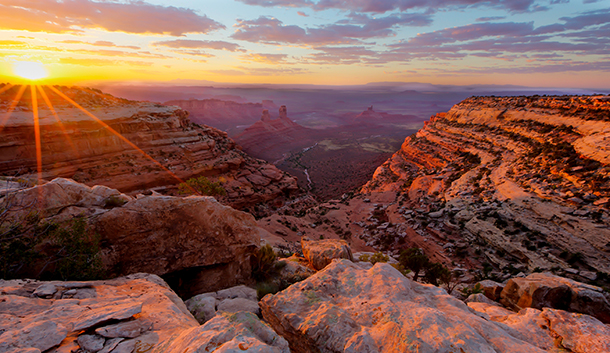
Bears Ears was granted National Monument status in 2016 and encompasses 1.3 million acres of land in southern Utah. (Photo: Bureau of Land Management, Flickr CC BY 2.0)
CURWOOD: From PRI, and the Jennifer and Ted Stanley Studios at the University of Massachusetts Boston, this is Living on Earth. I’m Steve Curwood.
The Trump Administration has fired another shot in the long-smoldering Sagebrush Rebellion, this time with a preliminary recommendation from Interior Secretary Ryan Zinke that the 1.3 million acre Bears Ears National Monument should be shrunk and perhaps fragmented.
Since the 1970’s rightwing activists and lawmakers in the Western States have called for more state and local control of the vast federal acreage in the region, seeking more access for mining, drilling and cattle grazing. And when President Trump came into office he ordered a review of all national monuments decreed since 1996. There are racial overtones. President Obama created Bear’s Ears monument at the end of his term in response to concerns of Native Americans who have deep spiritual and cultural ties to the area.
Tracy Coppola, a Senior Legislative Counsel at Earthjustice joins us now from Washington D.C. Welcome to Living on Earth Tracy!
COPPOLA: Thanks so much for having me.
CURWOOD: First, from your perspective, why is Bears Ears National Monument of particular importance?
COPPOLA: When you think about Bears Ears, you just think about how sacred that land is. It has a remarkable amount of archaeological, cultural sites, over 100,000 Native American treasures, ancient dwellings, pre-historic ruins. It's an amazing place to recreate and to really celebrate public lands, so this is very much a treasured land that I think we all love and celebrate.
CURWOOD: Why did President Trump ask Secretary of Interior Ryan Zinke to look at Bears Ears? There's some 27 national monuments that he asked him to review, but in particular he asked him to review this first and with a short turnaround on his report.
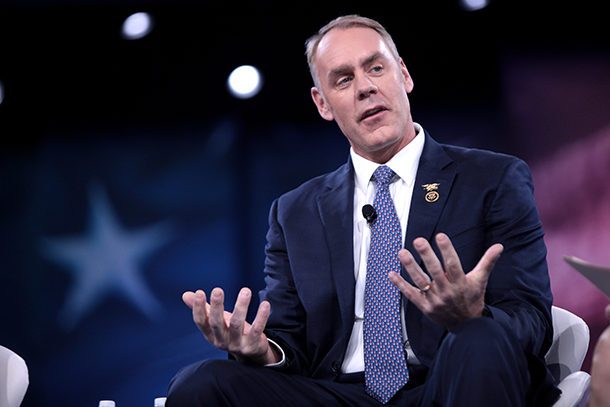
Interior Secretary Ryan Zinke is currently reviewing 27 National Monuments following an Executive Order by President Trump. (Photo: Gage Skidmore, Flickr CC BY-SA 2.0)
COPPOLA: This was clearly a political strategy on the Trump administration. They had been hearing from the Utah delegation who really didn't want to see this land as a National Monument. Definitely there are industry interests that are chomping at the bit to tear apart this land. Certainly, what the president and his administration wasn't looking at was, all the folks on the ground and of course the historic partnership of the intertribal coalition that wanted to see this land protected.
CURWOOD: Now, some folks in Utah would say, “Wait a second. There's a lot of protected lands in this general area.” There's Grand Staircase. Escalante, that's a National Monment. You go north of there, there's Capital Reef, that's a national park. How fair is that assessment by the locals there in Utah that there's just too much land being protected?
COPPOLA: Well, when you think about Bears Ears, you look at what would this land be without the national designation, and the sacred value of this land can't beat overstated. I mean, this is home to ancient cliff dwellings and Native American cultural sites and, not to mention, wildlife, but also it was being looted, there was grave robbing, vandalism. So, it desperately needed protection.
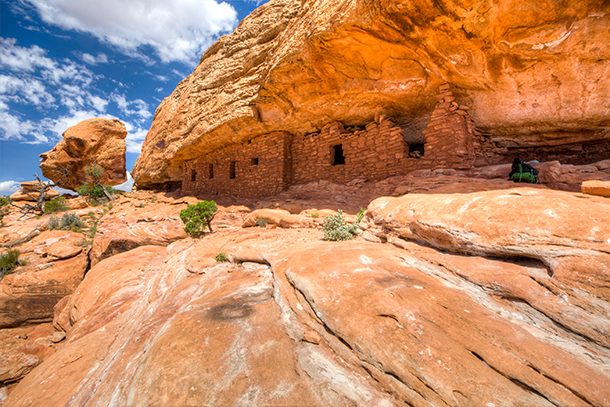
Native American dwellings and petroglyphs are abundant in the Bears Ears National Monument. (Photo: Bureau of Land Management, Flickr CC BY 2.0)
CURWOOD: So, Secretary Zinke says he's not recommending that President Trump try to revoke the National Monument status of Bears Ears, but rather that it should be "right sized". What does that mean exactly? What's he talking about?
COPPOLA: What it looks like is, there's going to be a significant reduction in the size of this monument, and from what the recommendation looks like, it's going to be so parceled-out or so shrunk that it's really going to be an insignificant protection. So, I think that there's a lot at risk here, and we always say, an attack on one is an attack on all.
So, this not only would be very tragic for Bears Ears and the stakeholders and the tribes that have fought for years for this designation, but really it would be an affront to all public lands lovers and really all Americans because this is all our land.
CURWOOD: So, what kind of precedent is there for shrinking or removing a National Monument?
COPPOLA: So, there really is no precedent for a president to remove or revoke a National Monument, and no president actually has attempted to, for good reason. Legal scholars and others are in agreement that no president has the legal authority to eliminate or significantly alter a National Park or a National Monument. Really that's something that only Congress has the authority to do.
So, this entire process, which really has been a very strange process in that the Bears Ears National Monument -- We only had 15 days at first to comment. That's an incredibly short time for a National Monument comment. It really is an unprecedented time -- and so far between EarthJustice and several other national groups, over one million comments have been collected, and for Bears Ears alone, we almost had 700,000 comments. That's a historic amount of comments for 15 days, all in support of the Monument.
CURWOOD: So, President Trump asked for this review. As you say, the president doesn't have the power to shrink or even revoke a National Monument, but the Congress certainly does. To what extent are you concerned that Secretary Zinke’s review will wind up in a bill that will then be presented in Congress? What is the risk that legislation to either shrink or even revoke the National Monument status of Bears Ears could get through?
COPPOLA: Well, it's definitely something that we've been seeing for a number of Congresses, that there've been a lot of bills introduced to sell off public lands. If that does happen, I do think that even at a bipartisan level there's an overwhelming support for these lands, but, you know, here in DC we see on a weekly basis these type of threats on our public lands. I think that it’s going to be a challenge for such a bill to even go through. It would face a lot of opposition.

Tracy Coppola is a Senior Legislative Counsel with Earthjustice and has been closely following the Interior Department review of the Bears Ears National Monument. (Photo: courtesy of Tracy Coppola)
CURWOOD: Tracy, before you go, tell me, what comes next?
COPPOLA: Well, we have a public comment that ends on July 10th, and that is for all of the National Monuments that the executive order included and that also now includes Bears Ears. After that, at the end of August, we're going to see a report from Interior on the 26 Monuments at stake, and that we'll have recommendations to the president and then we'll see. EarthJustice has put it out there that if Trump follows Zinke’s recommendation to shrink Bears Ears, we're going to see him in court because this is illegal, and also the public needs to know about it.
CURWOOD: Tracy Coppola is Senior Legislative Council at EarthJustice in Washington. Thanks so much for taking time with us today.
COPPOLA: Thank you so much.
Related links:
- NY Times: “Interior Secretary Recommends Shrinking Borders of Bears Ears National Monument:”
- President Trump's Executive Order calling for a review of National Monuments
- About the Bears Ears National Monument
- Learn more about the Bears Ears Inter-Tribal Coalition
Beyond the Headlines
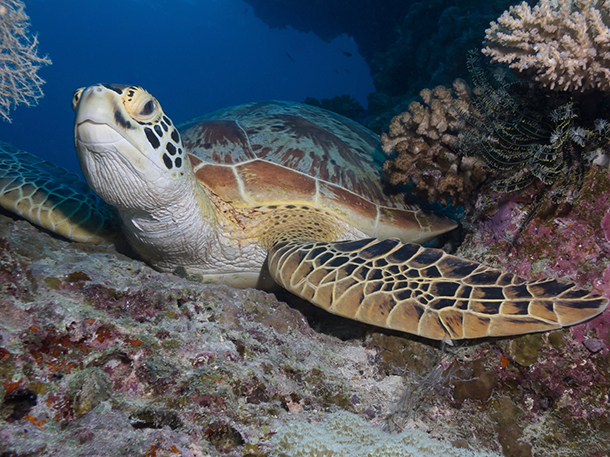
A green sea turtle rests in a stretch of the Great Barrier Reef off the coast of Northern Queensland. A new study from James Cook University suggests these turtles may be carrying bacteria resistant to most antibiotics. (Photo: Green MPs, Flickr, CC BY-NC-ND 2.0)
CURWOOD: Well, it’s been several weeks, but once again Peter Dykstra joins us now on the line from Atlanta for a look beyond the headlines. Peter is with Environmental Health News, ehn dot org and DailyClimate dot org, and he’s been battling a nasty bug. I’m glad you’re back, Peter, and how are you doing?
DYKSTRA: Hi, Steve. I’m still looking at a long recovery, but let’s just say that nasty bugs are much on my mind these days, so let me give you two more. A study published in the Marine Pollution Bulletin found that green sea turtles on the Great Barrier Reef were showing increasing signs of carrying bacteria resistant to anitibiotics that are used in human and veterinary medicine.
CURWOOD: Huh, antibiotic resistance is a growing problem on farms and hospitals and elsewhere, but in a place we consider as pristine as Australia’s coral reefs?
DYKSTRA: Yeah, even as we learn that the reef itself is under serious threat from warming temperatures. The researchers from James Cook University suspect the huge sea turtles are picking up the antibiotic-resistant bugs on contaminated beaches elsewhere and bringing them to the reef. And while marine researchers keep an eye on the reef, halfway around the world, something is infected in the state of Denmark.
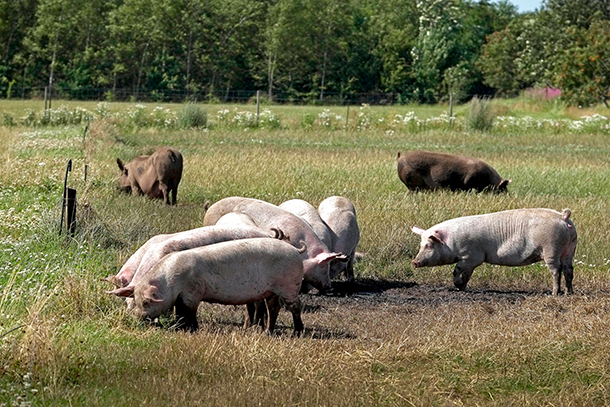
Pigs graze on a farm in the Jutland region of Denmark. American and Danish scientists have identified a “pig MRSA” that is widely resistant to standard antibiotics on many hog farms in the Scandinavian country. (Photo: News Oresund, Flickr CC BY 2.0)
CURWOOD: Well, there’s nothing like a little Shakespeare mixed in with your antibiotics, Mr. Dykstra.
DYKSTRA: You bet, and research from American and Danish scientists published last month in the journal Clinical Infectious Diseases reported the spread of what is to date a mild blood infection confined mostly to large hog farms. But the staph infection known as livestock-associated MRSA is widely resistant to standard antibiotics and could be poised to spread. And all this in Denmark, a nation with some of the strictest controls on the use of farm antibiotics.
CURWOOD: Oh boy, that’s one more thing to keep an eye on. Well, hey, Peter, what about our usual look in the environmental history vault? What do you have for us today?
DYKSTRA: Well, seven years ago this week, Texas Congressman Joe Barton – Critics often nickname him "Smoky" Joe Barton for his apparent closeness to the fossil fuel industry – demanded an apology from the Obama Administration for what Barton saw as a shakedown of BP over the Gulf of Mexico oil spill.
CURWOOD: Yeah, but if my memory serves, by that time, BP had already issued its own apology for the Deepwater Horizon spill.

U.S. Congressman Joe Barton speaks at a 2015 Lincoln Day dinner in Fort Worth, Texas. Commonly referred to as “Smoky” Joe Barton, the Republican politician became well-known for his demand that the Obama Administration apologize for their treatment of BP following the Deepwater Horizon oil spill. (Photo: Gage Skidmore, Flickr CC BY-SA 2.0)
DYKSTRA: They had, but that wasn’t what Congressman Barton wanted. He pretty much accused the White House of extorting money from BP for the spill. Then he backed off the apology demand. Then he kind of reinstated it. Then, like so many of these exquisite moments in environmental history, everybody forgot about it and moved on.
CURWOOD: Well, we’re glad that you’re back to remind us of it all. Peter Dykstra is with EHN.org and DailyClimate.org. Talk to you again real soon Peter. Great to have you back!
DYKSTRA: Yeah, I’m glad to be back too, Steve, and glad to be on the mend.
Related links:
- Sydney Morning Herald: “Drug-resistant superbugs hitch a ride on Great Barrier Reef turtles”
- Mother Jones: “We Have No Way of Knowing if This Scary Superbug Has Already Hit the United States”
- Watch: Rep. Joe Barton (“Smoky Joe”) apologizes to BP for $20 billion claims fund
[MUSIC: Sarah McLachlan, “Blackbird” on I Am Sam, by Paul McCartney, V2 Records.]
CURWOOD: Coming up...a promising breakthrough in preventing malaria. Stay tuned to Living on Earth.
ANNOUNCER: Support for Living on Earth comes from the Gordon and Betty Moore Foundation, and from a friend of Sailors for the Sea, working with boaters to restore ocean health.
[CUTAWAY MUSIC: Burt Bacharach, “The Windows Of the World,” by Burt Bacharach/Hal David on Music By Bacharach, Universal Music/Special Markets, courtesy of A&M Records]
A Tale of Two Numbers: Exxon’s Alleged Climate Fraud

ExxonMobil gas station sign (Photo: Mike Mozart, Flickr CC BY 2.0)
CURWOOD: It’s Living on Earth, I’m Steve Curwood. New York Attorney General Eric Schneiderman has subpoenaed the records of several ExxonMobil executives as part of his probe into allegations that Exxon knew about the dangers of climate change, but misled investors and promoted disinformation and denial of climate science.
The New York AG is seeking explanations for why the oil giant apparently used one set of numbers regarding climate regulatory and financial risks for investors, but a different, ‘secret’ set internally, to take a more aggressive stance in shaping its business strategy.
Dave Hasemyer of InsideClimate News is part of the team that has been investigating Exxon and he joins me now. Welcome to Living on Earth!
HASEMYER: Steve, thank you. I appreciate being here.
CURWOOD: So, first tell me, what evidence does New York Attorney General Eric Schneiderman have that Exxon had essentially two sets of books, two sets of numbers regarding climate change.
HASEMYER: Yeah, he has Exxon's public statements, made to the SEC, made through various investor publications, and he recently came across some internal documents, primarily some email discussions between Exxon executives, including Exxon’s greenhouse gas manager, in which it became clear that that discussion was about which numbers were most accurate.
What Schneiderman is saying is that Exxon presented one picture to the public through the SEC filings and through its investor relations material, which showed the company was being conservative when it was planning for the potential effects on the company's business related to any regulations that might reduce the need for fossil fuels, while internally they were using a much more aggressive number that showed the company had far less risk than was being related to the public.
CURWOOD: Dave, by the way, what about these allegations that the CEO of Exxon, Rex Tillerson, had a doppelganger, had a avatar, a different email for some of these discussions?
HASEMYER: He did have a separate email that he used for sensitive, internal Exxon business, and it was created under the pseudonym "Wayne Tracker". Tillerson’s middle name is Wayne. He's Rex Wayne Tillerson, and he had that account established so that he could avoid the massive amount of emails that flooded his Exxon account. And Exxon says that a lot of the emails flooding his account were coming from environmental organizations, urging the company to become more responsible.

This is not the first time New York Attorney General Schneiderman has taken on a powerful fossil fuel adversary. He led a two-year investigation, which culminated in 2015, that found that coal heavyweight Peabody Energy had not been forthright with investors and regulators about business risks related to climate change. (Photo: New York Attorney General’s Office)
CURWOOD: To what extent are there allegations that that was used to conceal this alleged deception of investors?
HASEMYER: That's what Schneiderman wants to find out. He wants to know exactly how Tillerson used it, and he wants to know what was said in those emails. And that's where Schneiderman is finding some issues because at least one year and maybe up to seven years-worth of those emails have been wiped away and may not be available.
CURWOOD: Mysteriously erased, huh?
HASEMYER: They were automatically erased by Exxon's computer system. When Exxon set up its emails, it had what Exxon called “a file sweeper,” so that the computer system after 13 months would automatically delete old emails. That file sweeper system was disabled for Rex Tillerson's primary account because Exxon, through its legal department, knew that Tillerson as well as a number of other Exxon executives may have a reason to keep their email, for litigation, for business purposes. But so few people in either Exxon's legal department or its IT department knew of Tillerson's secondary account that that automatic deletion system was not disabled. So, consequently, every 13 months, it wiped out emails. Rex Tillerson's Wayne Tracker account was created in 2007, and one of Exxon's IT persons, under a sworn statement to Schneiderman's office, acknowleged that his emails on Wayne Tracker may well have been swept away by this system going back to 2007.
CURWOOD: But, Dave, we know that emails are impossible to completely destroy, that they are intermediate servers, they’re in a number of places. So, these may eventually surface, I would imagine.
HASEMYER: And Exxon has made the representation to the New York Attorney General's Office that it has employed about 50 of its IT staff and invested many thousands of hours to try to recover them. It has brought in an outside forensic recovery service to aid in recovering them. Exxon is going through other email accounts where the sweeper system may not have been activated, so that any email exchanges between Tillerson may be preserved on someone else's account.
CURWOOD: Now, Dave, there are actually three court cases underway in connection with the Exxon investigation. I believe they're all lawsuits that ExxonMobil itself has brought. What's the company seeking with those cases?

Massachusetts Attorney General Maura Healey is conducting a separate, but similar, investigation into Exxon’s alleged misleading of investors about the risks climate change poses to its business. (Photo: Massachusetts Attorney General’s Office)
HASEMYER: What Exxon is saying is that those investigations are inappropriate because it infringes on Exxon's First Amendment rights to freely discuss climate change and issues related to climate change. What Exxon is saying is that Schneiderman and Massachusetts Attorney General Maura Healey are engaged in basically a political witch hunt to try to silence Exxon because Exxon doesn't tow what it says is the philosophical line that Schneiderman and Healey believe that it should be expressing on climate change.
CURWOOD: So, the reasoning here is that an allegation of deception, any discussion by the parties that were left on the record, is simply free speech and has nothing to do with possible conspiracy to deceive.
HASEMYER: That's Exxon's position, and a position, as you well know, that is being embraced by the Republican majority on the House Science Committee.
CURWOOD: Now, what happened to the coalition of some 17 Attorneys General, I think they call themselves “AGs United for Clean Power”, that seemed so promising when it was formed early last year.
HASEMYER: I've had the occasion to talk to a number of the Attorneys General who were announced as members of the coalition. One of them, Brian Frosh, the Attorney General of Maryland, explained that the coalition, in his terms, “exists in name only.” He said that there have been no addition meetings of the coalition, and as far as he knows, there's no other active investigations by any of the Attorneys General. In conversations that I've had with a number of former Attorneys General, they indicate that they're not surprised to see some of these AGs not getting involved in the face of Exxon's ferocious defense.
CURWOOD: Dave, how has Exxon responded to InsideClimate News during this probe of Exxon you guys have conducted?
HASEMYER: Initially, Exxon tried to discredit us as an advocacy organization, bought and paid for by other environmental organizations. It then simply said that much of our reporting and the use of the documents in our series "Exxon: The Road Not Taken" was nothing new, that all of that material was a matter of public record, and anybody could have simply gone back and taken a look at it and that Exxon early on acknowledged its climate research.

Dave Hasemyer reports for InsideClimate News, where in 2013 he was co-awarded a Pulitzer Prize in National Reporting. (Photo: InsideClimate News)
What Exxon then fails to say in its argument is that after its own scientists in the late ‘70s and early ‘80s went to the company describing the potential catastrophic consequences of global warming, the company went on a more than decades-long campaign to discredit basically its own science and tried to create doubt as to the consequences of global warming. That was Exxon's initial reaction. For about the last year-and-a-half, Exxon simply does not respond to our reporting.
CURWOOD: This is going to be a long process, it sounds like, Dave. So, where are you? Where are we as the public in this process in understanding what Exxon really did, in terms of allegedly deceiving the public about the risks of climate change, all along knowing what it knew?
HASEMYER: I think the public is certainly paying attention now as Schneiderman digs and digs and gets a little bit closer to, maybe not necessarily answers, but larger more clarifying questions because Schneiderman is now saying, “Look, we have these internal emails that show you folks debating whether you're using the right set of figures.”
And I have no idea if there is a direct correlation, but at the Exxon shareholder's meeting in late May, the shareholders voted, I believe about 62 percent, to approve a resolution that calls on Exxon to begin doing a better job of accounting for climate change as it moves forward with its business and assesses the risks to its business by climate change. And this is a resolution that Exxon has opposed for a number of years, and a resolution that has been defeated by the shareholders for a number of years. It's non-binding on Exxon, but it certainly delivers a strong message that 62 percent of its shareholders is telling Exxon, “Do a better job of assessing climate change risk to your business”.
CURWOOD: David Hasemyer is a reporter for InsideClimateNews. David, thanks so much for taking the time with us today.
HASEMYER: Steve, I appreciate it. It's been enjoyable. Thank you.
Related links:
- InsideClimate News: “Exxon Describes 2 Formulas for Climate Accounting in Court Filing”
- InsideClimate News: “Exxon May Have Erased 7 Years of Tillerson’s ‘Wayne Tracker’ Emails, Witness Says”
- InsideClimate News: “With Bare Knuckles and Big Dollars, Exxon Fights Climate Probe to a Legal Stalemate”
- Living On Earth’s earlier coverage of the Exxon shareholder resolution
- About Dave Hasemyer
[MUSIC: Sukshinder Shinda, “Dhamiwala Da Dhol” on Bhangra Beatz!, Kiss Records/Naxos World]
Science Note: Crab Shells Fight Malaria
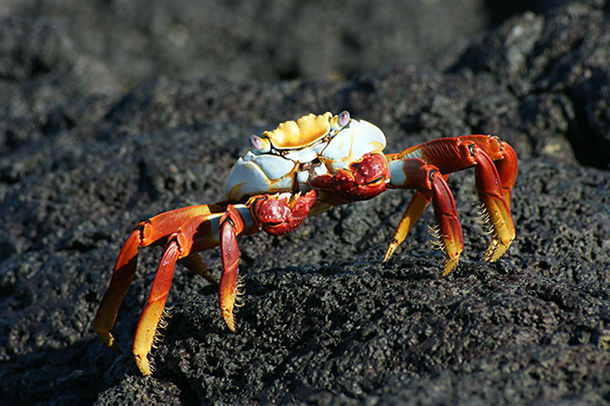
A Sally Lightfoot crab. (Photo: Tim Ellis, Flickr CC BY-NC 2.0)
CURWOOD: In a minute – the dark side of the brightly colored aquarium fish -- but first this note on emerging science from Don Lyman.
[MUSIC: SCIENCE NOTE THEME]
LYMAN: Despite over a century of prevention research, malaria continues to be a serious global health problem, particularly in Asia and Sub-Saharan Africa. The World Health Organization estimated that in 2013 there were nearly 200 million malaria cases and over half a million deaths. Though organophosphate insecticides are effective against mosquitoes that carry and transmit malaria, they can be toxic to many other insects and animals, including humans.
Now, scientists from the National Taiwan Ocean University have discovered a new and possibly environmentally friendly way of decreasing the spread of disease-carrying mosquitoes, by heading to the seashore. The researchers crushed oven-dried crab shells to extract chitin, a natural non-toxic substance also found in birds’ beaks and insect exoskeletons. It’s been used to manufacture such products as membrane water filters and biodegradable food packaging.
The researchers mixed the chitin with silver nitrate, a common laboratory chemical, to produce a solution of silver nanoparticles. They then sprayed this solution over six reservoirs at the National Institute of Communicable Disease Center in India. Even in small concentrations the solution killed mosquito larvae effectively, especially during the early stages of development, without affecting goldfish that also feed on the larvae.
The scientists concluded that chitin-silver nanoparticles are relatively easy to produce, stable over time, and strongly reduce mosquito populations. And because of its abundance in nature, chitin is cheap, and the amount of silver required is so limited that the treatment would be cost-effective.
That’s this week’s note on emerging science. I’m Don Lyman.
[MUSIC: SCIENCE NOTE THEME]
Related links:
- Link to the original study
- Centers for Disease Control and Prevention information on Malaria
Saving Fancy Fish
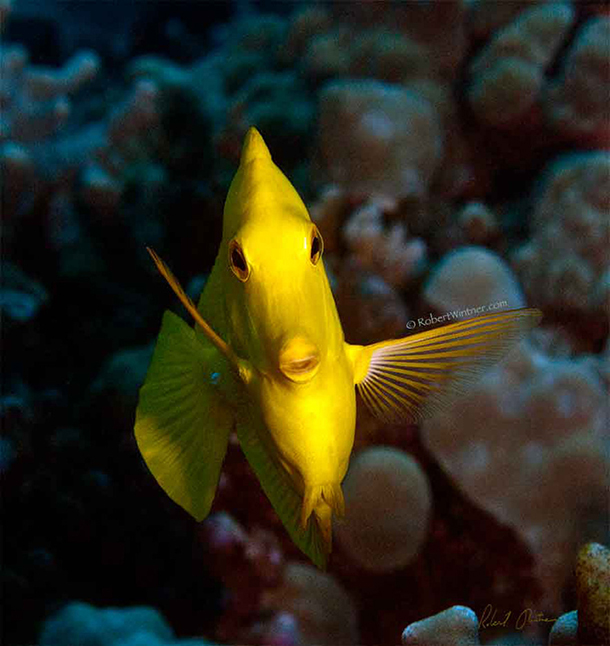
A Yellow Tang swimming in to say hello. (Photo: Robert Wintner)
CURWOOD: Awhile back we spoke with Robert Wintner – or as he’s known in Hawaii - Snorkel Bob, about his book “Reef Libre”, which celebrates Cuba’s fantastic, unspoiled reefs. And though he loves his diving, he is also driven to protect the colorful creatures of Hawaii’s coral reefs that are all too often at risk from trafficking in gorgeous tropical fish for aquaria. After an 11-year campaign Hawaii state legislators recently passed a bill to ban the aquarium trade within the archipelago, which the governor has yet to sign.
We called Robert Wintner in Maui to find out more. Aloha, Robert.
WINTNER: Aloha, Steve. It's good to be with you again.
CURWOOD: So, tell me what does the aquarium trade look like?
WINTNER: What it looks like up close and in person is not pretty. They drop anchors, chains, and nets onto coral. They use tickle sticks which are about 10 feet long, and they poke into the little nooks and crannies because the fish hide there when they see these guys. These guys are rough. They chase the fish out and they capture them in close mesh nets and put them in plastic containers, rush them to the surface for the long bouncy ride back to the harbor. The fish then get transferred to holding tanks. Every step of the way accumulates trauma, which is the biggest cause for mortality.
We take our mortality stats from a fellow who was considered one of the top gurus of the aquarium trade on Big Island. His name is Bob Fenner, and he wrote a book in which he said 99 percent of all fish taken die within a year of the point of capture.
CURWOOD: Robert, let me ask you. So, what's the mortality rate ten days after these fish have been captured, do you know?
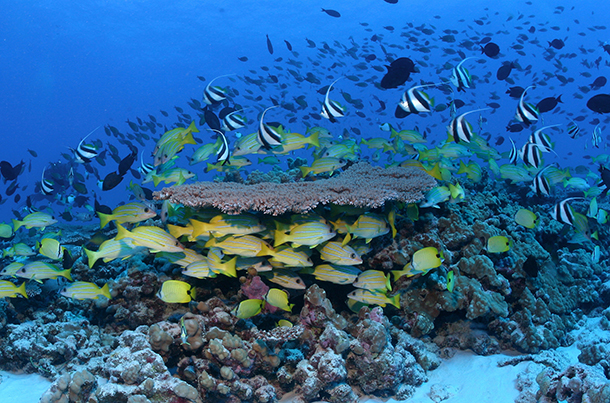
Pennant butterflyfish and bluestripe snapper swimming around lobe and table coral in Hawaii’s Papahānaumokuākea Marine National Monument. (Photo: James Watt/NOAA Office of Marine Sanctuaries, Flickr CC BY-NC-ND 2.0)
WINTNER: It's anybody's guess, it depends on the depth. There's a condition called barotrauma where a fish coming from great depth will bulge its guts and its eyes. They sometimes use a technique called fizzing where they puncture the air bladder with a hypodermic needle to release that pressure. Most the time they don't do that because time is money. Other fish die of contamination in their small plastic shipping bag where they use about a pint of water, and it depends on the individual, the cumulative stress, the trauma, how long they're going to last, and so mortality is all over the board.
CURWOOD: Give me the names of a few of the popular fish that are taken from Hawaii.
WINTNER: Well, Yellow Tang is number one. Also the second is called a Goldring Surgeon. In Hawaii it's a “kole,” a beautiful little herbivore. A big icon and a real fish of contention is a Hawaiian Cleaner Wrasse. He's charismatic. He sets up cleaning stations. They caught so many of them on the Kona Coast, that they started to suffer parasite loading of all the fish there. The high-end fish include, well, there's a Banded Angelfish that literally has a black mask over his eyes. Those are up to $1,000 each, or $1200. They used to be plentiful, they're not anymore. Some of fish that if you see one you just don't talk about, is an Eel Dragon Moray. They sell online for $1,000.
CURWOOD: So, tell me a bit about this bill. Why do you think it's needed?

The Goldring Surgeonfish is a popular aquarium fish (Photo: Robert Wintner)
WINTNER: Well, it's needed because the aquarium trade is a last vestige of wildlife trafficking to serve the pet trade in the world. I think one of the big issues on the table is that Hawaii's DLNR - That stands for Department of Land and Natural Resource - their entire argument is it's sustainable, and even though they're crying out it's sustainable, their argument is that they can still issue an unlimited number permits to an unlimited number of collectors and those collectors can take every single fish off any given reef.
CURWOOD: How tough was it to get this law passed, and what's the current status of the law now?
WINTNER: It was very tough because there is…People are surprised when they see how contentious this issue is. There's been a lot of bad feelings on both sides of the issue, and in the past we sought a total ban because that's what it calls for, and the big defense that they made is, “You're hurting our families, you're putting us out of work”.
So this year we came up with what we felt was a compromise. We're grandfathering in the current collectors. There's only 50 of them who are active. And so, this year was a huge breakthrough because we literally undermined their challenge of, “You're hurting our families,” and that's why this bill got through. And I have to tell you, Steve, we got through six legislative hearings in both the House and Senate. That led all the way to committee conference, and here we are awaiting Governor David Ige's signature.
CURWOOD: So, at the end of the day, which way do you think the governor's leaning on this?
WINTNER: I think he's going to sign the bill. I have reason to believe he's going to sign the bill.
CURWOOD: People don't often think that their fish comes from this rather destructive trafficking in aquarium fish that destroys or damages coral reefs and fish populations, and supporters say, “No, no no no, this is a sustainable process”. What do you say?

Hawaiian Cleaner Wrasse (Photo: Robert Wintner)
WINTNER: You just hit the nail on the head. Most people don't think about it at all, and if they do think about it, they think that somebody somewhere is raising these fish, and they're not. This is wildlife. As I say, the aquarium trade is a $4 to $5 billion industry. They will say anything they need to say to keep going. Hawaii has always been low-hanging fruit for the aquarium trade.
CURWOOD: How many fish, tropical fish are taken for the aquarium trade in Hawaii each year, do you think?
WINTNER: The used to report half a million, now they're up to a million, but the actual take is between two to five times the reported take. My gut feeling, it's in the neighborhood of six or seven million a year from Hawaii. You know, Indonesia and the Philippines are worse because they use dynamite and cyanide to capture those fish. Their mortality is through the roof. The trade exploits the people who capture the fish. They're given them a few pennies on a fish that will retail for 150 bucks.
CURWOOD: Tell us a bit about how the aquarium trade has affected the Yellow Tang in Hawaii.
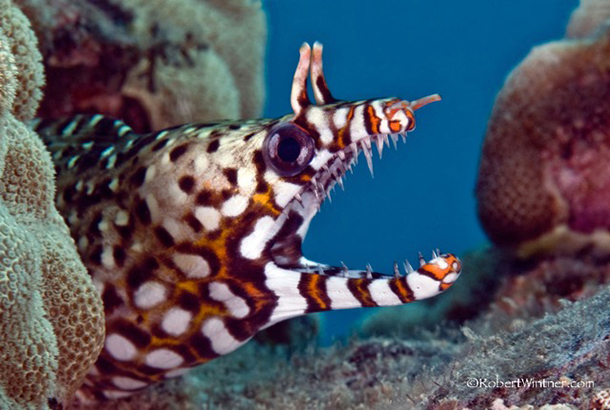
Dragon Moray (Photo: Robert Wintner)
WINTNER: The Kona Coast used to be called the gold coast because of its perfectly crystal blue water, and when the shore break came in, and the waves would rise to a crest you could see through them, and in those waves would be hundred thousands of millions of Yellow Tangs. They're not there anymore. They're taking anywhere between two and 10 million Yellow Tangs in a year.
CURWOOD: What big concerns do you have for the illegal trafficking in tropical fish for the aquarium trade if, in fact, this bill becomes law?
WINTNER: My feeling is that if this bill becomes law and these fish become contraband vis-à-vis export, will we reduce the take to zero? No, but we'll bring it down from the millions to a few thousand. We will see recovery.
CURWOOD: So, why not breed these fish in captivity?
WINTNER: Can't do it. Two percent of all aquarium species are captive bred. If the state wants to spend money, that's where it should focus its research.
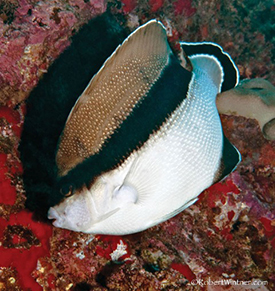
Bandit Angel Fish (Photo: Robert Wintner)
CURWOOD: So your advice to people who might want to keep fish at home is, what, keep it to a guppy?
WINTNER: No, I would advise people there are flat-screen TVs now with closed loops. There's Reefcam. It's going to be better action at greater depth than you're ever see in a glass tank. You'll have zero mortality. You won't have any maintenance or feeding, and there you go.
CURWOOD: Robert Wintner, a.k.a. Snorkel Bob, has been tirelessly campaigning to end aquarium trade of reef fish in Hawaii. Robert, thanks so much for taking the time with us today.
WINTNER: Thank you, Steve. Again, I appreciate your interest, and I'm happy to be here anytime.
Related links:
- Hawaii Tribune-Herald poll
- Snorkel Bob Campaign Site
- Yellow Tang
- Goldring Surgeonfish
- Hawaiian Cleaner Wrasse
- Bandit Angel Fish
- Dragon Moray
Gulls Hunting Spider Crabs

Two juvenile Herring Gulls spar over a tasty spider crab. (Photo: Mark Seth Lender)
CURWOOD: We stay at the seaside now to consider one of its most persistent creatures, seagulls.
Some people find them annoying, as they aggressively attempt to filch food from beach picnics, when they aren’t scavenging around garbage dumps or simply quarreling among themselves. But our Explorer in Residence Mark Seth Lender wants to set the record straight. Mark watches gulls on the Connecticut Shore near his home and says they’re smart and resourceful and surprisingly great hunters.
Gulls Hunting Spider Crabs
© 2017 Mark Seth Lender
All Rights Reserved
LENDER: The sun comes up like a crucible of molten ore, and the horizon is the anvil, and the waves the hammer of the forge. Then, when every sign warns of the storm that is to come, the wind gives out, the sea grows calm. Fog, thick as coal smoke, rises and drifts toward shore.
Now, on the middle grounds where the ocean shallows to a knee-deep pool, again where the rip of the tide curls along the bite, crustaceans with their ten arms each leave the bottom reaching for the light. Driven by Life’s most fundamental need they rise. A myriad of Spider Crabs.
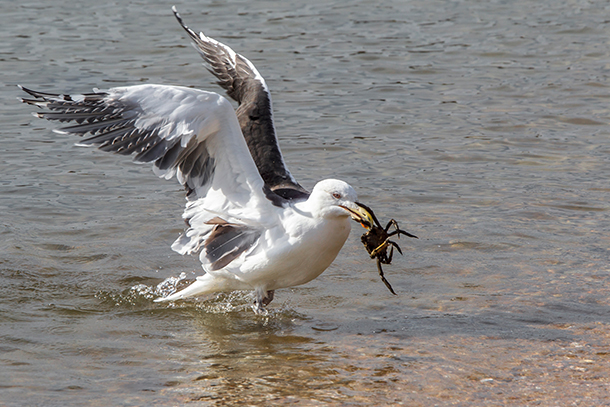
Adult Black-backed Gull returns from the water with a spider crab. (Photo: Mark Seth Lender)
Wings and webbed feet aligned to meet them. Long yellow bills sharp as teeth will greet them:. Black-backed Gulls and Herring Gulls. The Ravening of the Horde
Gulls torpedo headfirst wings tucked, buried up to the shoulder. Water splashing voices crashing each and almost every plunge they surface with a dark star, an array of spiny arms, the pincers snapping. Black-backed Gulls and Herring Gulls each hold their angry prize, just out of reach of bright gull eyes.
The “skree-ree-ree-ree-ree!” of Herring Gulls and the clacking of their wings. The “raw-craw!” of the Black-backs. Yearling gulls whistling in indignation, that incoming class of always-hungry freshman, and what one finds another one wants. Theft, not possession, is the nine out of 10 parts.
So they land on the beach and throw a crab down and lift it up and nibble an arm and pin it there with the point of beak. Better to be the ones that eat!
Now over the deep the gulls go soaring. Then down, where waves ring against the rocks like the clattering of bells. Where the pilings are draped in blue mussel shells. Where breakers comb the seaweeds, dark green tresses. Where barnacles like sequined dresses shimmer with the tide and the end of summer warms the night.

A first year juvenile Herring Gull prepares to devour its prize. (Photo: Mark Seth Lender)
Full in the belly, Black-backed Gulls and Herring Gulls preen and close their eyes, content.
Spider crabs? All spent.
[WAVES AND BLACK-BACK AND HERRING GULLS CALLING]
CURWOOD: And to see some of Mark Seth Lender’s pictures, wing on over to our website LOE dot org.
[WAVES AND BLACK-BACK AND HERRING GULLS CALLING]
Related links:
- More about seagulls, including the ones Mark knows on a first-name basis
- Learn more about the Stewart B. McKinney National Wildlife Refuge
CURWOOD: Coming up, how a major hurricane that hits Houston could hurt not just the region but the whole country. That’s just ahead here on Living on Earth. Stay tuned.
ANNOUNCER: Funding for Living on Earth comes from you our listeners, and United Technologies - combining passion for science with engineering to create solutions designed for sustainability in the aerospace, food refrigeration and building industries. UTC companies such as Otis, Carrier, Pratt & Whitney and UTC Aerospace Systems are helping to move the world forward.
This is PRI, Public Radio International.
[CUTAWAY MUSIC: B.J. Leiderman and Bela Fleck, “Bela BJ 3” by B.J. Leiderman]
Houston Hurricane Risks

The Houston Ship Channel is one of the U.S.’s busiest seaports. (Photo: Michael Stravato)
CURWOOD: It’s Living on Earth, I’m Steve Curwood. Hurricane season began the first of June, and forecasters expect to see 10 named storms, and three could be doozies. And for some US cities, the risk is considerable.
Take Houston, Texas, America’s fourth largest city, with a metro population of more than 6 million. Houston is home of the nation’s largest refining and petrochemical complex, vital for manufacturing jobs and our oil supply.The Texas Tribune and ProPublica recently won the prestigious Peabody Award for their joint investigation of Houston’s vulnerability to a major hurricane. By the way Galveston, Texas was supposed to become the major port on the Gulf of Mexico, but, thanks to a historic hurricane, Houston which is further up Galveston Bay, became the regional economic hub instead.
And Neena Satija with the Reveal investigative team and the Texas Tribune is here to tell us the story. Welcome to Living on Earth, Neena.
SATIJA: Thank you so much for having me.
CURWOOD: Nina, give me a brief synopsis of Houston's history with hurricanes, the major storms that have reeked havoc on the city in the past - and don't leave out Galveston.
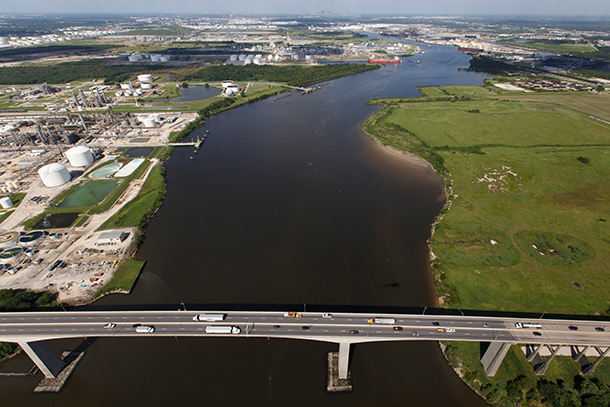
Refinery complexes along the Houston Ship Channel in September 2016. (Photo: Michael Stravato)
SATIJA: Yeah, so Galveston actually in 1900 was a port city. It was supposed to be the Houston of America and of the world. Instead, it got pummeled by this huge hurricane in the year 1900 that killed thousands of people, and, as a result of that, Houston now exists. That really paved the way for Houston to become the port city of America.
CURWOOD: What exactly about the geography of the city puts it at risk? I understand that there's a ship channel. What does that do in a storm?
SATIJA: Right, so the thing to think about first is actually Galveston Bay, and it's almost, like, I would think of Galveston Bay as some kind of bowl. Now, when a storm is coming in from the Gulf of Mexico, that bowl starts to fill up. The water's getting higher than the rim of this bowl, and the rim is, of course, all of the beaches that are all around Galveston Bay. So, this bowl fills up, and the water spills onto the shore over the rims.
But on top of that, inside this kind of bowl, you have a, if you will, a 50 mile channel. That channel continues another 15, 20 miles or so inland. As the water gets funneled into the channel, it's an even narrower space for this water to go through, so it spills out over the edge onto land even more quickly and with even more damage.
CURWOOD: Sounds like the same situation in New Orleans where they have the Mississippi River Gulf outlet, known as the Mister Go, that was a channel that brought the storm surge of Katrina right into town.
SATIJA: Yes, definitely there's some similarities. Now, of course, New Orleans is below sea level. Houston is not below sea level. Houston is dozens of feet above sea level, but, you know, when you have the right storm hitting at the right angle, you can have that kind of effect, and of course Houston doesn't have any levies or sea wall. Galveston does have a sea wall that was built after the 1900 storm, but it's not all that high, it’s probably about 15, 17 feet high, and the scenarios we're looking at could definitely overtop that sea wall.
CURWOOD: Now, your investigation found a number of studies that projected what the storm surge would be in the Houston area from a substantial storm. Just how a big storm surge were these studies looking at?
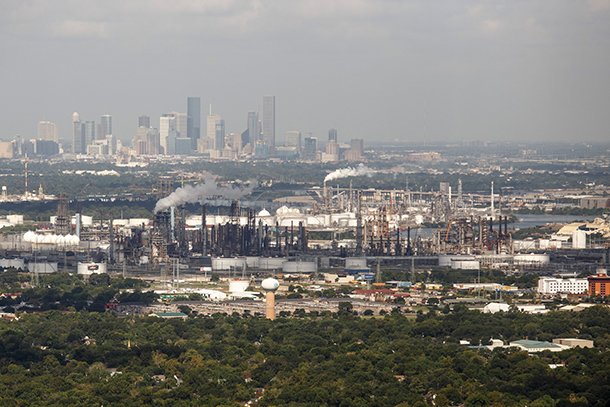
Houston, Texas, is one of the fastest growing cities in the United States with a population of over 2 million people. (Photo: Michael Stravato)
SATIJA: It depends on where you are, but if we're looking at the Houston ship channel and some of the most industrial parts of the Houston area right along that channel, we're talking 25 to 30 feet of storm surge. Now, you know, areas along the ship channel could be anywhere from 15 to 20 feet above sea level, so the water isn't going to go 30 feet above land, but it's still going to go five or 10 feet above land.
CURWOOD: Talk to me about what's in the path of the storm surge, both in the terms of where people live but also what's there in Houston's industry.
SATIJA: Yeah, so I think what makes this probably the most important for the world and for the country to be watching is the Houston ship channel and this petrochemical complex, as it's called, petrochemical and refining complex. You have several oil refineries that are right along the Houston ship channel. If you look at a satellite view on Google maps, you'll really see how close they are to the water.
You also have a number of other types of manufacturing facilities, plastics. You know, any kind of factory that needs oil to manufacture something, it's probably along the Houston ship channel. So, we're talking about people that make tennis balls, anything with rubber, tires, Tupperware, the medicine that you take is like 99 percent pill and one percent medicine. The 99 percent of that pill, chances are, that some components of that are made along the Houston ship channel. So, all of these different industries and big manufacturing facilities and oil refineries are definitely at risk.
The other thing that’s at risk, of course, are people. We're talking about millions who live in the Houston area. Depending how you look at it, I think hundreds of thousands who might really be at risk when you're talking about flooding. Of course, hopefully they’ll have evacuated, but we've seen issues with that in the past. Certainly along Clear Lake there's a large residential population. It's very dense. It's basically the suburbs of Houston, and it's growing and growing every year. Those folks like to live on the beach. They like to live on the water. So, really, you see houses that are right up against the water, and some that really aren't all that elevated.
CURWOOD: So, what about the storage tanks, the oil and chemical storage tanks there?
SATIJA: So, we know from satellite data and scientific research, that there are thousands of storage tanks lining the Houston ship channel, and I really encourage people listening to actually go take a look at our project. It's got some satellite imagery. But also just look on Google maps. I mean, really, just go there and zoom in on the Houston ship channel, and you will see these little dots right next to the water.
Government regulations certainly do require safety measures. These tanks have to withstand pretty high wind speeds, but there's really nothing in the regulations that talk about storm surge. And what could happen with storm surge is, this rushing water could lift a tank off of its foundation, and these are huge tanks. I mean, some of them are football fields wide. They could float around. They could hit things. They could fall back down, any one of those things causing them to rupture and leak, and that's exactly what happened during Hurricane Katrina.
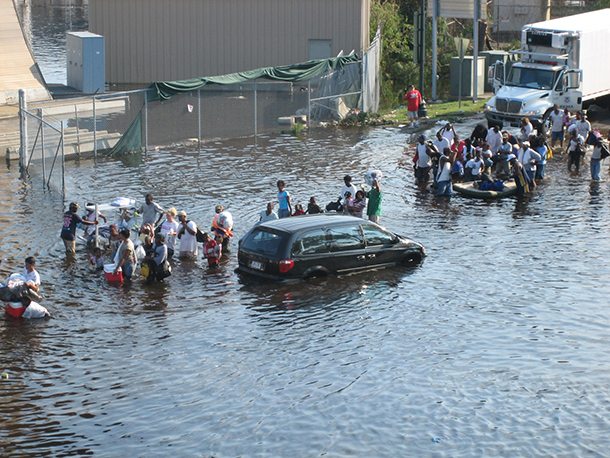
Residents of New Orleans seek higher ground in the wake of Hurricane Katrina. The Mississippi River Gulf Outlet, known as “MR-GO,” channeled Katrina’s storm surge right into the city – and the Houston Ship Channel could have a similar effect. (Photo: News Muse, Flickr CC BY-NC-ND 2.0)
CURWOOD: Now, back in 2008, Hurricane Ike was making its way towards the Texas coast. What happened in that case?
SATIJA: What people projected would happen was the scenarios that we're talking about now, 20, 25 foot storm surge on the Houston ship channel, 20, 25 foot storm surge on Clear Lake, thousands of people dead. Rick Perry, the governor at the time, actually spoke to my boss at the Texas Tribune and said about a million people would be dead. That's probably an overestimate, but certainly in the thousands, and people didn't evacuate. That was the other thing. Especially on Clear Lake people did not take the storm threat seriously, and they didn't evacuate, and that's why we think so many people would have died had the storm not taken the course that it did. But just a few hours before it was set to make landfall, it kind of turned at the last minute, and so it just ended up hitting a different area that didn't have the same types of risks that the Houston area had.
CURWOOD: Looking at a couple of the studies you cited in your story, it looks like the odds of a fairly serious storm in the Houston area over the next 30, maybe 50 years is about one in 10. I'm not sure I'd be willing to get on an airplane if it had a 10 percent chance of crashing. How is the city responding to this risk, if there's a 10 percent chance that it really could trash the city of Houston with a hurricane?
SATIJA: Yeah, you know, we did not get a lot of answers from the city of Houston on this. We reached out to the mayor at the time, still the Mayor, Sylvester Turner, and we got this kind of odd statement back basically saying, “We're really more worried about wind damage within the city of Houston's borders. You know, storm surge isn't a big deal for us”.
This really doesn't make a ton of sense, just scientifically. Parts of Clear Lake are in the city of Houston within the city's borders, so storm surge does matter to them, but, of course, even if you have an entire town flooded that's right on the border of the city of Houston, you're going to have problems. People aren't going to be able to get to work. People aren't going to be able to get to the hospital. So, it didn't really seem like they wanted to engage, frankly, on this issue.
Now, the former mayor of Houston Annise Parker did make a big deal of this. Her way of looking it, I think, is, you've got, you know, thousands of people moving to Texas a day, many of them moving to Houston. Some of them are moving from coastal areas - California, New York - but some of them are moving from places where they don't know anything about hurricane risk, and you're going to have to convince them to engage on this issue, to pay for this issue, and that's going to be a really really tough thing to do.
CURWOOD: Yeah, so how aware are people in Houston that the odds are, say, about one in 10 that the city could get really whacked with a tough hurricane over the next 30 or 50 years?
SATIJA: I don't think most people are aware. It's certainly something that a lot of real estate agents don't want to talk about. People who have lived their whole lives in Houston, have been there for decades, are a lot more aware. But it's funny, even though people like that that we spoke to were certainly aware, they were also like, “This is never going to happen", right?” I mean, imagine living in Houston for 30 years and getting this kind of warning every couple of years, every summer, that there's going to be a big one and it doesn't hit, and that's what makes this actually even more dangerous. When people don't take the threat seriously, that means that when it finally does you really have a big problem.
CURWOOD: So, what kind of plans have been developed by the city and the region to deal with this threat, and what kind of progress in those plans has been made since you published your report?
SATIJA: I'd say the main progress, since we’ve published our investigation, is there's been more talk about the need to build a barrier of some kind. I don't think anyone has yet completely agreed on what should be built, but everyone does seem to now agree, we need to build a storm surge barrier for the Houston area, and they have some consensus on what it should look like.
It's going to kind of go probably between Galveston and Bolivar islands. It's going to cross a little section of Galveston Bay. It's going to be a large gate of some kind, and it's going to probably cost essentially more than $20 billion to build. Some progress has been made on actually planning how that barrier should be built, what it should look like. President Obama signed a law last December that included some language that could help expedite this process of doing a study. Even then, it's probably going to take five or 10 years to build, something like that. So, not much else has been done, that we're aware of, to protect the city and the region in the meantime.
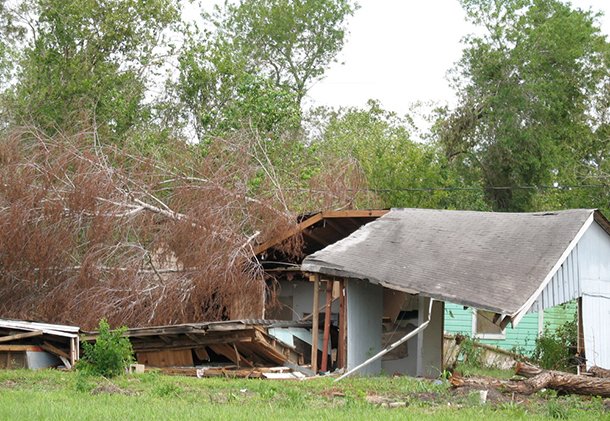
Damage caused by Hurricane Ike in 2008. (Photo: PINKE, Flickr CC BY-NC 2.0)
CURWOOD: You suggested a barrier wall would cost $20 billion. How much damage would be done by major storm there in Houston if there isn't such a barrier? What's the estimate for that?
SATIJA: I think the estimate is around $100 billion, potentially more than $100 billion. So, Ike cost about $30 billion of damage, that's the estimate. I would think Katrina and Sandy were both on the order of $100 billion in damage as well. So, we're looking at, you know, one of the most costly storms that we've ever had in this country, in modern history. That's no question. If we get one of these direct hit storms, category 4 or 5, you know, high enough wind speed hitting at the right angle, we will have thousands of deaths.
CURWOOD: Now, I don't want to sound callous, in fact, my dad was from Houston and I have cousins in the area, but this is disastrous for Houston if something happens. What about the rest of America?
SATIJA: I think it's certainly disastrous for the rest of America. I mean, even Katrina, we saw increased gas prices for a long time even after hurricane Ike, in fact, we saw an increase in gas prices nationwide. But, really, if you have that direct hit type of scenario on Houston, in the Houston area, you're going to see -- we've heard economist tell us, $7, $8, $9 a gallon gas for months because you're talking about some of the nation’s largest refineries, in fact, the nation's largest refineries on the Houston ship channel potentially, if not being damaged, at least having to go offline for months at a time.
CURWOOD: So, some sort of a barrier wall is $20 billion and a number of years away. What are the most important changes the city could make right now to protect its citizens even before this barrier goes up?
SATIJA: We've talked to a number of cities and counties and the state on this and they say, "Well, we do the hurricane preparedness drills. Ycan go to our website". I'm not convinced that people, especially the people who are moving to the area, that are new to the area, are aware of the risk. We've talked to people who have moved into a 100-year flood zone and didn't know. So, certainly more could be done on awareness.

Neena Satija is a reporter and radio producer for the Texas Tribune and Reveal, a public radio program from the Center for Investigative Reporting. (Photo: Texas Tribune)
The second thing that these cities and towns could be doing is updating, changing their building codes, changing their building regulations. That's not probably going to protect against the type of storm scenario that we're talking about, you know, the one in 500 storm a year, but it will certainly protect against the smaller storms, the floods that Houston's getting sometimes two or three times a year right now.
Some cities did update their building codes after Ike to increase minimum elevation, but really not much else was done. There's a huge amount of development happening in Houston and the surrounding areas. Houston doesn't have any zoning. It's just not something that's talked about very much, so I do think that...You know, we talked to many scientists who said that, "Look, there are things we can do beside build a storm surge barrier".
I think the barrier at this point has become a way of saying, we can reach out to a government or an industry and say, "Hey, what are you doing to prepare for hurricanes", and they say, "Oh, we're supporting a storm surge barrier". It doesn't really make a lot of sense for your public in the next 10 years. It's great to support the storm surge barrier, but there's something that you need to be doing right now.
CURWOOD: To what extent it is a major hurricane disaster going to hit poor people harder than rich people, or this is an equal opportunity disaster waiting to happen?
SATIJA: Well, it's funny you asked me that. I still remember...That just reminds me of an interview that we did in Galveston, where we spoke to a couple who lived in a really nice kind of beach home and they didn't evacuate. They were OK, thankfully, but they did, you know, get stuck on the island for a while, and they remember having to stand in line to get sort of their rations at a FEMA tent or something like that, and it was just all different walks of life types of people standing in this line and they were really struck by the equalizing factor that a storm has.
But certainly people who are poor are, I think, going to be affected more especially because a lot of those folks live in these industrial towns along the Houston ship channel. They're the ones who live closer to these refineries, to these facilities. If they can't evacuate, I think they are at greater risk of not just flooding, but something worse happening and then actually still being at home to experience that and suffer through that. Of course, on the evacuation side, you know, if you don't have a car, evacuating is going to be really difficult. Depending on where you live, how far you live from the highway, evacuating is going to be really difficult, but people who are the most vulnerable are going to be the ones that are going to have trouble decorating that's probably the scariest part of this.
CURWOOD: Neena Satija is a reporter with the Reveal Center for Investigative Journalism and the Texas Tribune. Nina, thanks for taking the time with us today.
SATIJA: Thanks a lot, Steve.
Related links:
- ProPublica: The Full Investigative Report
- Reveal | The Reveal podcast on the Hurricane risk in Houston
- CNN | Texas asks Trump for a storm surge barrier
[MUSIC: Claude Hopkins, “Stormy Weather” on Swing Time, by Ted Koehler/Harold Arlen, Prestige Records, reissued on Concord Records]
CURWOOD: Our crew includes Naomi Arenberg, Bobby Bascomb, Savannah Christiansen, Jenni Doering, Matt Hoisch, Noble Ingram, Jaime Kaiser, Don Lyman, Lizz Malloy, Alex Metzger, Helen Palmer, Adelaide Chen, and Jolanda Omari. Tom Tiger engineered our show, with help from Jeff Wade and Jake Rego. Alison Lirish Dean composed our themes. You can hear us anytime at LOE.org - and like us, please, on our Facebook page - PRI’s Living on Earth. And we tweet from @LivingonEarth. I'm Steve Curwood. Thanks for listening.
ANNOUNCER1: Funding for Living on Earth comes you, our listeners, and from the University of Massachusetts, Boston, in association with its School for the Environment, developing the next generation of environmental leaders. And from the Grantham Foundation for the protection of the environment, supporting strategic communications and collaboration in solving the world’s most pressing environmental problems. Support also comes from the Energy Foundation, serving the public interest by helping to build a strong, clean, energy economy, from Carl and Judy Ferenbach of Boston, Massachusetts and from SolarCity, America’s solar power provider. SolarCity is dedicated to revolutionizing the way energy is delivered by giving customers a renewable alternative to fossil fuels. Information at 888-997-1703. That’s 888-997-1703.
ANNOUNCER2: PRI. Public Radio International.
Living on Earth wants to hear from you!
Living on Earth
62 Calef Highway, Suite 212
Lee, NH 03861
Telephone: 617-287-4121
E-mail: comments@loe.org
Newsletter [Click here]
Donate to Living on Earth!
Living on Earth is an independent media program and relies entirely on contributions from listeners and institutions supporting public service. Please donate now to preserve an independent environmental voice.
NewsletterLiving on Earth offers a weekly delivery of the show's rundown to your mailbox. Sign up for our newsletter today!
 Sailors For The Sea: Be the change you want to sea.
Sailors For The Sea: Be the change you want to sea.
 The Grantham Foundation for the Protection of the Environment: Committed to protecting and improving the health of the global environment.
The Grantham Foundation for the Protection of the Environment: Committed to protecting and improving the health of the global environment.
 Contribute to Living on Earth and receive, as our gift to you, an archival print of one of Mark Seth Lender's extraordinary wildlife photographs. Follow the link to see Mark's current collection of photographs.
Contribute to Living on Earth and receive, as our gift to you, an archival print of one of Mark Seth Lender's extraordinary wildlife photographs. Follow the link to see Mark's current collection of photographs.
 Buy a signed copy of Mark Seth Lender's book Smeagull the Seagull & support Living on Earth
Buy a signed copy of Mark Seth Lender's book Smeagull the Seagull & support Living on Earth

